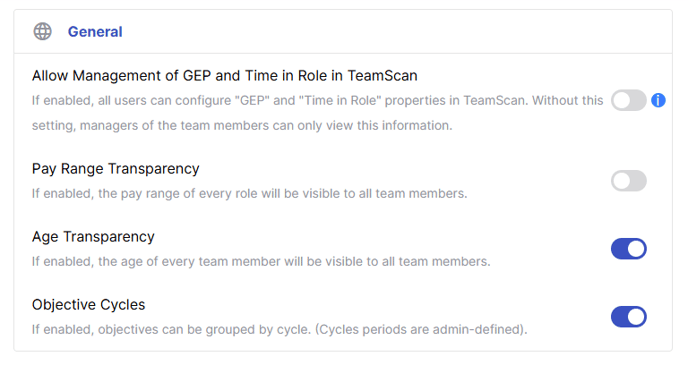This guide provides an overview of the available settings and explains the consequences of enabling or disabling each option.
In General Settings, you have the ability to turn certain options on or off.
You can find them by navigating to Administration > Settings > General.

Allow Management of GEP and Time in Role in Team Scan:
Purpose: Controls who can configure the “GEP” and “Time in Role” properties in TeamScan.
We don’t recommend this, as the GEP is defined by the organization for each role and is the core of the methodology.
All team members in the same role share the same GEP, and managers do not set the role’s expectations.
Managers’ responsibility is to assess the operating mode of team members against these expectations, which they can always provide feedback on in the Teamscan.
Impact:
- Enabled: The manager can edit the “GEP” and “Time in Role” fields for their team members in TeamScan.
- Disabled: The manager can view this information but cannot make changes. The administrator must ensure all roles and team members are correctly assigned so that everyone has the appropriate GEP and Time in Role.
Pay Range Transparency:
Purpose: Determines whether the pay range for each role is visible to all team members.
This refers to the Role Description & Profile (RDP) library. It is a field within the RDP that can be either visible or hidden.
Impact:
- Enabled: Every team member can see the pay ranges for all roles.
- Disabled: Pay range information remains hidden and visible only to admin roles that have access to Admin>RDP.
Age Transparency:
Purpose: Controls whether the age of each team member is visible to anyone that has access to them (manager/head of dept/admins).
Impact:
- Enabled: Age information is displayed only for the individuals the user has access to. In addition, it enables the use of age-related filters and the visualization of age-related charts in TeamScan > Insights.
- Disabled: Age information is hidden from the general user view.
Objective Cycles:
Purpose: Allows objectives to be grouped and managed by specific time cycles.
Impact:
- Enabled: Objectives can be organized into admin-defined cycles (e.g., quarterly, yearly). Note that enabling cycles does not require users to assign a cycle to every objective; it is not a mandatory field.
- Disabled: Objectives can be created independently of cycles, providing flexibility for ongoing goal management.